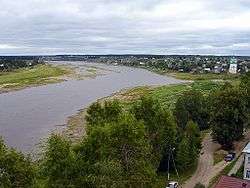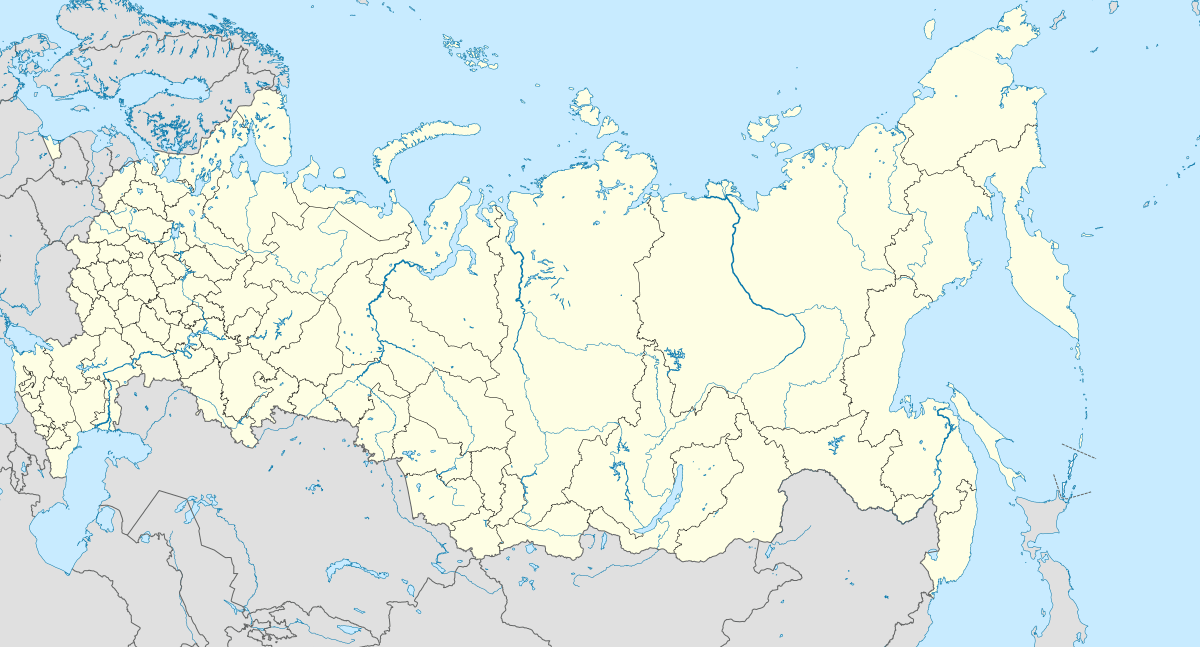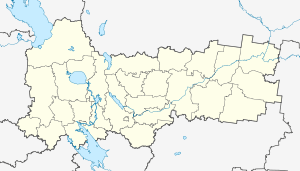Totma
Totma (Russian: То́тьма) is a town and the administrative center of Totemsky District in Vologda Oblast, Russia, located on the left bank of the Sukhona River at its confluence with the Pesya Denga, 217 kilometers (135 mi) northwest of Vologda, the administrative center of the oblast. Population: 9,785 (2010 Census);[5] 10,531 (2002 Census);[10] 10,622 (1989 Census).[11]
Totma Тотьма | |
|---|---|
Town[1] | |
 The Sukhona River in Totma | |
.png) Flag .png) Coat of arms | |
Location of Totma 
| |
 Totma Location of Totma  Totma Totma (Vologda Oblast) | |
| Coordinates: 59°58′N 42°45′E | |
| Country | Russia |
| Federal subject | Vologda Oblast[1] |
| Administrative district | Totemsky District[1] |
| Town of district significance | Totma[2] |
| First mentioned | 1137[3] or 1138[4] |
| Elevation | 130 m (430 ft) |
| Population | |
| • Total | 9,785 |
| • Estimate (2018)[6] | 9,805 (+0.2%) |
| • Capital of | Totemsky District[1], town of district significance of Totma[2] |
| • Municipal district | Totemsky Municipal District[7] |
| • Urban settlement | Totma Urban Settlement[7] |
| • Capital of | Totemsky Municipal District[7], Totma Urban Settlement[7] |
| Time zone | UTC+3 (MSK |
| Postal code(s)[9] | 161300 |
| OKTMO ID | 19646101001 |
History
It was first mentioned in the chronicles in 1137 (according to other sources—in 1138[4]) as the pogost of Todma (Тодма).[3] It was founded by Novgorodians, who used the Sukhona as the main waterway leading to the north and eventually to the White Sea. The name "Totma" is nevertheless of Finno-Ugrian origin, which, together with archeological discoveries, indicates that an earlier settlement on the site of the present town was established by the Merya people. The original pogost was located 16 kilometers (9.9 mi) downstream of the current location, close to the mouth of the Staraya Totma River.[3] In the 13th century, salt production started around Totma and the town was relocated. In 1539, Totma was plundered by Kazan Tatars;[3] a fortress was built after this event.[4] In 1554, monk Feodosy Sumorin founded the Transfiguration Monastery.[3] In the 16th–17th centuries, Totma was one of the most prosperous towns of the Russian North, due to the trade and to the salt production.[3] In the 17th and 18th centuries, Totma was visited several times by Peter the Great,[3] which was rather exceptional given the remote location of the town.
In the course of the administrative reform carried out in 1708 by Peter the Great, Totma was included into Archangelgorod Governorate and named one of the towns constituting the governorate.[12] In the 18th century, Totma was one of the main centers of the exploration of and the trade with Alaska.[3] In particular, Ivan Kuskov, the first administrator of Fort Ross, a Russian fortress in California, was a native of Totma.[3] In 1780, Totma became the seat of Totemsky Uyezd of Vologda Viceroyalty,[3] and since 1796 it was a part of Vologda Governorate.[4]
In the 19th century, Totma quickly lost its significance[3] as the foreign trade was rerouted from Arkhangelsk to St. Petersburg and the river transportation was gradually replaced by railways and highways. The railway from Vologda to Arkhangelsk was constructed along the shortest way via Konosha and bypassed Totma, while the old highway from Moscow to Arkhangelsk never ran via Totma. Until the late 1990s, the only road through Totma connected Vologda with Veliky Ustyug via Nikolsk. In the second half of the 19th century, Totma was frequently used as a destination for political exile.[4]
On July 15, 1929, several governorates, including Vologda Governorate, were merged into Northern Krai and the uyezds were abolished. Totma became the administrative center of Totemsky District, which included parts of former Totemsky Uyezd.
Administrative and municipal status
Within the framework of administrative divisions, Totma serves as the administrative center of Totemsky District.[1] As an administrative division, it is incorporated within Totemsky District as the town of district significance of Totma.[2] As a municipal division, the town of district significance of Totma is incorporated within Totemsky Municipal District as Totma Urban Settlement.[7]
Economy
Industry
The most important industry in Totma is the food industry.[13]
Transportation
Paved roads connect Totma with Vologda via Kadnikov (southwest), Veliky Ustyug via Nyuksenitsa (northeast), and Nikolsk via Imeni Babushkina (east). Before the road between Totma and Veliky Ustyug along the Sukhona was completed in the first decade of the 2000s, the only connection between the towns was via Nikolsk.
The Sukhona is navigable in Totma; however, there is no passenger navigation.
Culture and recreation
Totma is a historical town which preserved, along with other heritage, several churches which have all similar structure not related to any other region of Russia. A Totma church is a building on which the church proper is based on one side and the bell-tower on the other side so that the construction reminds a ship. This style is sometimes referred to as Totma Baroque.[14]
Totma contains twelve objects classified as cultural and historical heritage by Russian Federal law and additionally seventy-four objects classified as cultural and historical heritage of local importance.[15] The town of Totma is classified as a historical town by the Ministry of Culture of Russian Federation, which implies certain restrictions on construction in the historical center.[16]
The monuments classified as cultural heritage by the federal law are the following:


- The complex of the Resurrection Church and the Assumption Church (1744–1755)
- The Nativity Church (1746–1748)
- The Trinity Church in Zelenskaya Rybatskaya Sloboda (1768–1772)
- The complex of the Church of the Entry into Jerusalem and the Church of St. John the Baptist (1738–1740)
- The Kholodilov House (middle of 19th century)
- The ensemble of Spaso-Sumorin Monastery (1685–1689)
- The town hall
- The house where Anatoly Lunacharsky lived in 1903-1904
Totma hosts five six museums:[17]
- The Totma Regional Museum, founded in 1915. Feodosy Vakhrushov, a landscape painter, was the founder of the museum, and the museum presents a display of his paintings
- The museum of Church Antiquities
- The House of Ivan Kuskov
- The museum of Sea Explorers (in the building of the Church of the Entry into Jerusalem)
- The museum of artifacts in Spaso-Sumorin Monastery
- The Ship-Building Museum
References
Notes
- Resolution #178
- Law #371-OZ
- Энциклопедия Города России. Moscow: Большая Российская Энциклопедия. 2003. p. 475. ISBN 5-7107-7399-9.
- Н. В. Солдатова (2006). Г. В. Судаков (ed.). Вологодская энциклопедия (PDF) (in Russian). Вологда: ВГПУ, Русь. p. 474. ISBN 5-87822-305-8. Retrieved November 26, 2013.
- Russian Federal State Statistics Service (2011). "Всероссийская перепись населения 2010 года. Том 1" [2010 All-Russian Population Census, vol. 1]. Всероссийская перепись населения 2010 года [2010 All-Russia Population Census] (in Russian). Federal State Statistics Service.
- "26. Численность постоянного населения Российской Федерации по муниципальным образованиям на 1 января 2018 года". Federal State Statistics Service. Retrieved January 23, 2019.
- Law #1124-OZ
- "Об исчислении времени". Официальный интернет-портал правовой информации (in Russian). June 3, 2011. Retrieved January 19, 2019.
- Почта России. Информационно-вычислительный центр ОАСУ РПО. (Russian Post). Поиск объектов почтовой связи (Postal Objects Search) (in Russian)
- Russian Federal State Statistics Service (May 21, 2004). "Численность населения России, субъектов Российской Федерации в составе федеральных округов, районов, городских поселений, сельских населённых пунктов – районных центров и сельских населённых пунктов с населением 3 тысячи и более человек" [Population of Russia, Its Federal Districts, Federal Subjects, Districts, Urban Localities, Rural Localities—Administrative Centers, and Rural Localities with Population of Over 3,000] (XLS). Всероссийская перепись населения 2002 года [All-Russia Population Census of 2002] (in Russian).
- "Всесоюзная перепись населения 1989 г. Численность наличного населения союзных и автономных республик, автономных областей и округов, краёв, областей, районов, городских поселений и сёл-райцентров" [All Union Population Census of 1989: Present Population of Union and Autonomous Republics, Autonomous Oblasts and Okrugs, Krais, Oblasts, Districts, Urban Settlements, and Villages Serving as District Administrative Centers]. Всесоюзная перепись населения 1989 года [All-Union Population Census of 1989] (in Russian). Институт демографии Национального исследовательского университета: Высшая школа экономики [Institute of Demography at the National Research University: Higher School of Economics]. 1989 – via Demoscope Weekly.
- Указ об учреждении губерний и о росписании к ним городов (in Russian)
- Структура видов экономической деятельности (in Russian). Администрация Тотемского муниципального района. Retrieved November 26, 2013.
- Брамфилд, Уильям (2000). Памятники церковной архитектуры Тотемского района (in Russian). Поморский государственный университет имени М.В.Ломоносова. Archived from the original on June 6, 2011. Retrieved October 3, 2011.
- Памятники истории и культуры народов Российской Федерации (in Russian). Russian Ministry of Culture. Retrieved June 2, 2016.
- Министерство культуры Российской Федерации. Приказ №418/339 от 29 июля 2010 г. «Об утверждении перечня исторических поселений». Вступил в силу 10 октября 2010 г. Опубликован: "Российская газета", №219, 29 сентября 2010 г.. (Ministry of Culture of the Russian Federation. Order #418/339 of July 29, 2010 On Adopting the Registry of the Historic Settlements. Effective as of October 10, 2010.).
- Музеи Тотьмы (in Russian). Российская сеть культурного наследия. Retrieved November 26, 2013.
Sources
- Законодательное Собрание Вологодской области. Закон №371-ОЗ от 4 июня 1999 г. «О вопросах административно-территориального устройства Вологодской области», в ред. Закона №2916-ОЗ от 7 декабря 2012 г. «О внесении изменений в Закон области "О вопросах административно-территориального устройства Вологодской области"». Вступил в силу со дня официального опубликования. Опубликован: "Красный Север", №124–125, 29 июля 1999 г. (Legislative Assembly of Vologda Oblast. Law #371-OZ of June 4, 1999 On the Matters of the Administrative-Territorial Structure of Vologda Oblast, as amended by the Law #2916-OZ of December 7, 2012 On Amending the Oblast Law "On the Matters of the Administrative-Territorial Structure of Vologda Oblast". Effective as of the day of the official publication.).
- Правительство Вологодской области. Постановление №178 от 1 марта 2010 г. «Об утверждении реестра административно-территориальных единиц Вологодской области», в ред. Постановления №686 от 25 июня 2012 г. «О внесении изменений в некоторые Постановления Правительства области». Вступил в силу 20 марта 2010 г. Опубликован: "Красный Север", №29, 20 марта 2010 г. (Government of Vologda Oblast. Resolution #178 of March 1, 2010 On Adopting the Registry of the Administrative-Territorial Units of Vologda Oblast, as amended by the Resolution #686 of June 25, 2012 On Amending Various Resolutions of the Oblast Government. Effective as of March 20, 2010.).
- Законодательное Собрание Вологодской области. Закон №1124-ОЗ от 6 декабря 2004 г. «Об установлении границ Тотемского муниципального района, границах и статусе муниципальных образований, входящих в его состав», в ред. Закона №3670-ОЗ от 1 июня 2015 г. «О преобразовании некоторых муниципальных образований Тотемского муниципального района, о внесении изменений в Закон области "Об установлении границ Тотемского муниципального района, границах и статусе муниципальных образований, входящих в его состав" и изменения в Приложение к Закону области "О некоторых вопросах организации и деятельности органов местного самоуправления на территории Вологодской области"». Вступил в силу через 10 дней со дня официального опубликования. Опубликован: "Красный Север", №242, 11 декабря 2004 г. (Legislative Assembly of Vologda Oblast. Law #1124-OZ of December 6, 2004 On Establishing the Borders of Totemsky Municipal District, on the Borders and Status of the Municipal Formations It Comprises, as amended by the Law #3670-OZ of June 1, 2015 On the Transformation of Several Municipal Formations in Totemsky Municipal District, on Amending the Law of the Oblast "On Establishing the Borders of Totemsky Municipal District, on the Borders and Status of the Municipal Formations It Comprises", and on Amending the Appendix to the Law of the Oblast "On Various Issues of Organization and Functioning of the Local Self-Government on the Territory of Vologda Oblast". Effective as of after 10 days from the day of the official publication.).
External links
- Уильям Крафт Брамфилд. Памятники церковной архитектуры Тотемского района (in Russian)